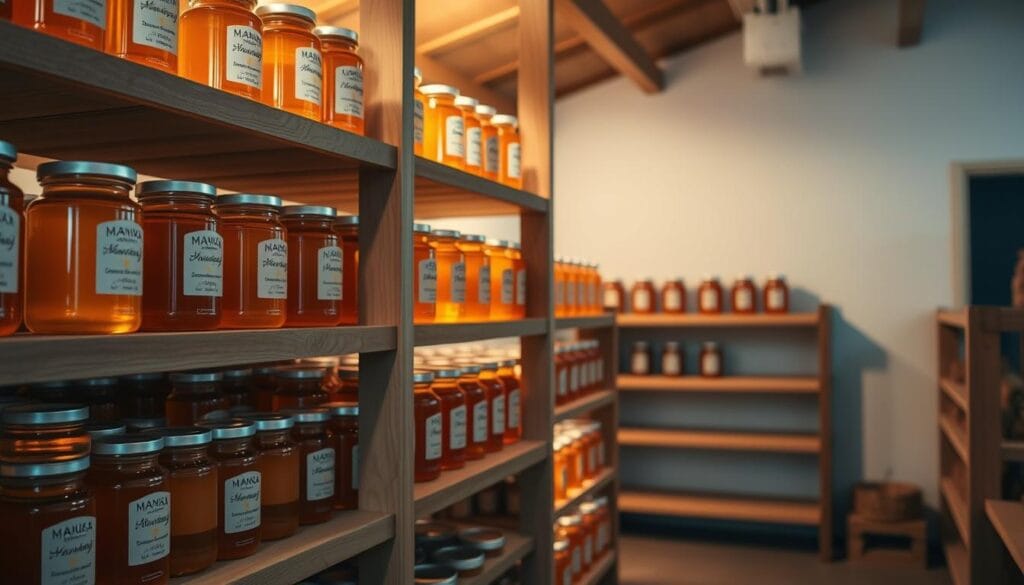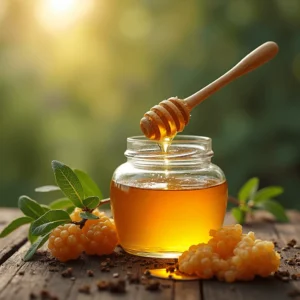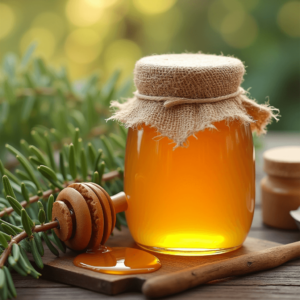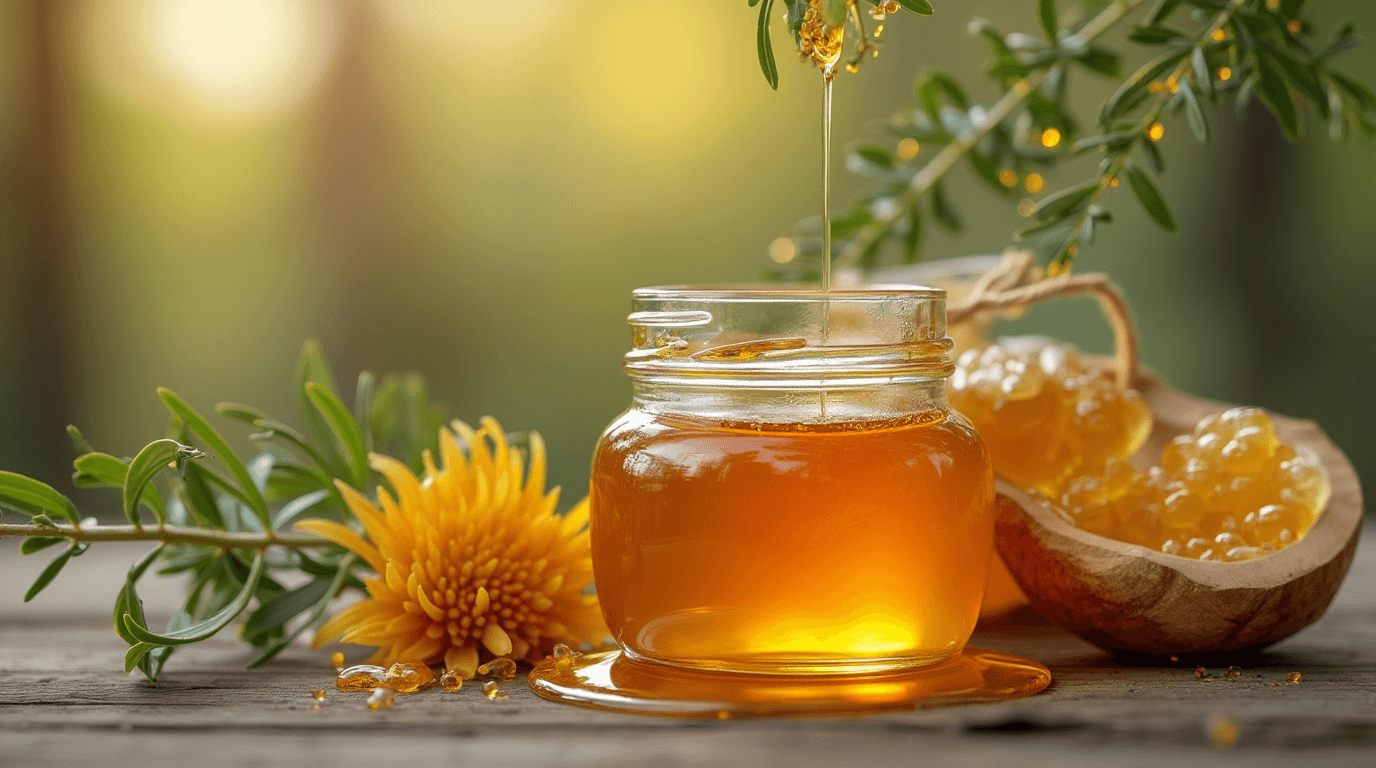Ever wondered why Manuka honey is more than just sweet? The safety data sheet (SDS) shows its complex biochemical makeup. This turns it from a simple sweetener into a powerful natural resource.
The Manuka honey SDS gives you key insights into its unique makeup. It comes from the nectar of New Zealand’s Leptospermum scoparium tree. This honey has special compounds like methylglyoxal (MGO) that make it different from regular honey.
Knowing the Manuka honey SDS is vital for those in food, healthcare, and research. It gives detailed info on its chemical makeup, uses, and safety for handling and use.
Key Takeaways
- Manuka honey comes from New Zealand’s native Leptospermum scoparium tree
- It has unique compounds like methylglyoxal with significant biological activities
- It’s crucial for professionals in food, healthcare, and research sectors
- Provides comprehensive safety and handling guidelines
- Offers insights into its extraordinary biochemical properties
Understanding Manuka Honey Composition and Properties
Manuka honey is a unique natural product with special chemical features. Its mix of nutrients and bioactive compounds sets it apart in the honey world.
Exploring Manuka honey’s composition, you find a rich mix of biochemical elements. These elements are key to its remarkable properties. The honey has components that make it different from other honeys:
- Methylglyoxal (MGO): Primary antibacterial agent
- Flavonoids: Including chrysin, pinobanksin, and pinocembrin
- Natural enzymes that enhance its therapeutic potential
Chemical Components and Active Ingredients
Manuka honey’s chemical makeup is a health powerhouse. Its unique hazard information comes from its strong antibacterial properties. These are mainly thanks to its methylglyoxal content.
Physical Properties and Characteristics
Manuka honey looks different from other honeys. It has a dark amber color and a thick, viscous texture. Its thick consistency shows how packed it is with bioactive compounds.
Methylglyoxal (MGO) Content Significance
The MGO content is key to the honey’s antibacterial strength. Higher MGO levels mean stronger antimicrobial effects. This is why Manuka honey is rated by the Unique Manuka Factor (UMF) system.
The higher the MGO content, the more powerful the honey’s therapeutic potential.
Knowing these details helps us see how special Manuka honey is. It shows its potential in health and wellness.
Manuka Honey SDS: Safety Classification and Labeling
It’s important to understand the manuka honey safety data sheet (SDS) for safe handling. The Globally Harmonized System (GHS) offers a standard way to classify and label chemical products. This includes special honeys like manuka.
Looking at a manuka honey SDS, you’ll find several key points:
- Hazard identification details
- Potential health impact assessments
- Safety recommendation guidelines
- Packaging and storage requirements
The safety classification for manuka honey looks at its special chemical makeup. This includes its methylglyoxal (MGO) content. This helps figure out risks and how to handle it safely.
| Classification Parameter | Typical Manuka Honey SDS Specification |
|---|---|
| Hazard Category | Low Risk |
| MGO Concentration Range | 100-550 mg/kg |
| pH Level | 3.2-4.5 |
| Microbial Safety | Meets Food Safety Standards |
Your manuka honey SDS gives detailed advice on safe storage and handling. It also talks about possible medical interactions. Always check the specific SDS for the right info for your product.
Hazard Identification and Risk Assessment
It’s important to know the risks of manuka honey for safe use. Manuka honey is great for health, but we must be careful. Knowing the hazards helps us take the right steps.
Potential Health Effects
Manuka honey can cause health issues that we need to watch out for:
- Allergic reactions in sensitive individuals
- Potential blood sugar level impacts
- Risk of infant botulism for children under 12 months
“Awareness of potential health impacts is key to responsible manuka honey handling instructions.” – Natural Health Research Institute
Environmental Impact Considerations
Manuka honey production and use affect the environment:
| Environmental Aspect | Potential Impact |
|---|---|
| Bee Population Sustainability | Critical for ecosystem balance |
| Habitat Preservation | Protecting native manuka tree regions |
| Carbon Footprint | Minimizing transportation emissions |
Emergency Response Guidelines
Here are steps for handling manuka honey emergencies:
- Skin Contact: Rinse thoroughly with water
- Eye Contact: Flush with clean water for 15 minutes
- Ingestion: Monitor for allergic reactions
- Seek medical attention if severe symptoms occur
Always consult healthcare professionals for personalized manuka honey handling instructions and potential health concerns.
Storage and Handling Requirements

Keeping manuka honey in the right conditions is key to its quality. The way you store and handle it affects its effectiveness and nutritional value. It’s important to follow the right steps to keep it fresh.
Here are some essential tips for handling manuka honey:
- Store in a well-ventilated, cool, and dry area
- Keep containers tightly sealed to prevent moisture contamination
- Maintain consistent temperature between 50-70°F (10-21°C)
- Avoid direct sunlight exposure
- Use clean, non-reactive containers for storage
Protecting the honey’s natural makeup is your main goal. Manuka honey is 100% honey and doesn’t need complex storage rules. It’s easy to handle and store.
Here are some important handling tips:
- Never feed honey to infants under one year old
- Use clean utensils when scooping
- Close container immediately after use
- Avoid introducing moisture or foreign substances
Manuka honey is stable and doesn’t react with water. This makes its storage simple. You don’t need special protection when handling it.
First Aid Measures and Emergency Procedures
Manuka honey is usually safe, but knowing first aid is key for emergencies. Your safety data sheet has important tips for handling different situations.
Exposure Response Protocol
Acting fast and right when dealing with manuka honey can help avoid risks. Here are some first aid steps for different situations:
- Skin Contact: Wash well with mild soap and water
- Eye Contact: Rinse with water for 15 minutes carefully
- Ingestion: Drink water and get medical help if problems last
- Inhalation: Go to fresh air and talk to a doctor
Medical Treatment Guidelines
Your manuka honey safety data sheet suggests these medical steps:
- Don’t make someone vomit unless a doctor tells you to
- Keep the person calm and warm
- Get medical help right away if there’s a big reaction
“Always prioritize professional medical guidance in emergency situations.”
Emergency Contact Information
Have these important emergency numbers ready:
| Contact Type | Number |
|---|---|
| Emergency Telephone | Chemtrec 1-800-424-9300 |
| Poison Control Center | 1-800-222-1222 |
Even though manuka honey is mostly safe, always follow your safety data sheet for the best health care.
Transportation and Shipping Guidelines


When you transport Manuka honey, you must follow special handling instructions. This is to keep its quality and special properties intact. You also need to stick to safety guidelines found in the manuka honey safety data sheet.
Before you ship Manuka honey, think about a few important things:
- Temperature control during transportation
- Appropriate packaging materials
- Protective sealing techniques
- Compliance with international shipping regulations
Here are some tips to keep your Manuka honey safe during shipping:
| Shipping Condition | Recommended Approach |
|---|---|
| Temperature Range | Keep between 50-70°F (10-21°C) |
| Packaging | Use food-grade glass or high-quality plastic containers |
| Shipping Method | Avoid extreme temperature fluctuations |
Professional tip: Always include clear labeling indicating fragile contents and temperature-sensitive product.
“Proper transportation ensures the preservation of Manuka honey’s unique medicinal properties.” – Honey Preservation Institute
Your shipping plan should focus on keeping the honey safe. This means avoiding contamination and ensuring it arrives safely at its destination.
Quality Control and Testing Protocols
Ensuring the highest quality of Manuka honey requires rigorous testing and precise analytical methods. Your understanding of manuka honey composition details is crucial for recognizing its true value and authenticity.
The quality control process involves comprehensive laboratory analysis that goes beyond standard honey testing. Researchers utilize advanced techniques to evaluate the unique characteristics of Manuka honey.
Laboratory Analysis Methods
Professional laboratories employ multiple sophisticated approaches to assess Manuka honey’s quality:
- Methylglyoxal (MGO) content measurement
- Unique Manuka Factor (UMF) rating determination
- Pollen analysis for geographic verification
- Spectrophotometric antioxidant assessments
Quality Assurance Standards
The manuka honey SDS requires strict adherence to established quality benchmarks. Key quality indicators include:
- MGO concentration levels
- Phenolic content verification
- Antibacterial property testing
- Trace element analysis
Compliance Documentation
Comprehensive documentation is essential for validating Manuka honey’s authenticity. Critical compliance documents include:
- Certificates of analysis
- Traceability records
- Origin verification reports
- Laboratory test results
By implementing these rigorous quality control protocols, producers ensure that each batch of Manuka honey meets the highest standards of purity and effectiveness.
Regulatory Compliance and Documentation
Understanding the rules for Manuka honey is key. Your safety data sheet is vital for showing you follow the rules in food and healthcare. Knowing what’s needed helps keep your product safe and meets strict standards.
Companies must create detailed documents about Manuka honey hazards. You need to get certifications from groups like the FDA and global bodies. It’s important to track where ingredients come from, how they’re processed, and any allergy risks.
Rules for moving Manuka honey in and out of countries differ. Your documents must show lab tests, chemical makeup, and quality checks. The safety data sheet is like a travel pass for your honey, sharing important details about its health effects and how to handle it safely.
Keeping up with new rules is essential to stay in the market. Training, joining industry events, and talking to regulators are important. Good document management means your Manuka honey is always safe and of high quality.
FAQ
What is a Manuka Honey Safety Data Sheet (SDS)?
What makes Manuka honey unique compared to other types of honey?
How is the safety of Manuka honey classified?
Are there any potential health risks associated with Manuka honey?
How should Manuka honey be stored?
What first aid measures should be taken in case of Manuka honey exposure?
How is Manuka honey transported safely?
How is the quality of Manuka honey verified?
What regulatory standards apply to Manuka honey?
How often should a Manuka Honey SDS be reviewed?
Source Links
- The Antioxidant Potential of Commercial Manuka Honey from New Zealand—Biochemical and Cellular Studies – https://pmc.ncbi.nlm.nih.gov/articles/PMC11275220/
- Manuka Honey Inhibits Human Breast Cancer Progression in Preclinical Models – https://pmc.ncbi.nlm.nih.gov/articles/PMC11279598/
- The comparison of the antioxidant, antibacterial and antiviral potential of Polish fir honeydew and Manuka honeys – Scientific Reports – https://www.nature.com/articles/s41598-024-82429-0
- Current Trends and Technological Advancements in the Study of Honey Bee-Derived Peptides with an Emphasis on State-of-the-Art Approaches: A Review – https://www.mdpi.com/2297-8739/11/6/166
- How Phenolic Compounds Profile and Antioxidant Activity Depend on Botanical Origin of Honey—A Case of Polish Varietal Honeys – https://www.mdpi.com/1420-3049/30/2/360
- Frontiers | Effect of low dose honey on the apoptosis and inflammation gene expression in corneal limbal stem cells and keratocytes and its efficacy as an ophthalmic formulation in the treatment of dry eye: in-vitro and clinical study – https://www.frontiersin.org/journals/medicine/articles/10.3389/fmed.2024.1359463/full
- Frontiers | Rooted in therapeutics: comprehensive analyses of Cannabis sativa root extracts reveals potent antioxidant, anti-inflammatory, and bactericidal properties – https://www.frontiersin.org/journals/pharmacology/articles/10.3389/fphar.2024.1465136/full
- Manuka Honey Inhibits Human Breast Cancer Progression in Preclinical Models – https://www.mdpi.com/2072-6643/16/14/2369
- Chemical Composition and Biological Activities of Lagopsis supina Extract: Antioxidant, Adipogenic, and Ani-Inflammatory Effects – https://www.mdpi.com/1424-8247/18/2/150
- Assessment of in vitro skin permeation and accumulation of phenolic acids from honey and honey-based pharmaceutical formulations – https://pmc.ncbi.nlm.nih.gov/articles/PMC11796271/
- Antibacterial activity of Hungarian varietal honeys against respiratory pathogens as a function of storage time – Scientific Reports – https://www.nature.com/articles/s41598-024-60961-3

1 thought on “Manuka Honey SDS: A Comprehensive Guide”